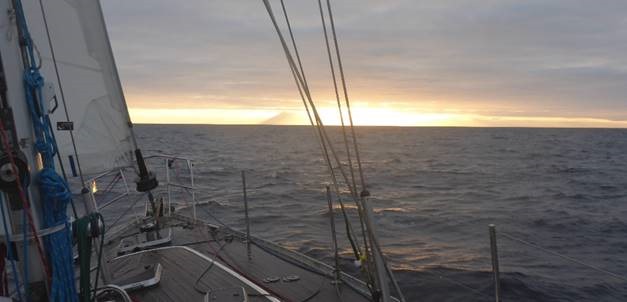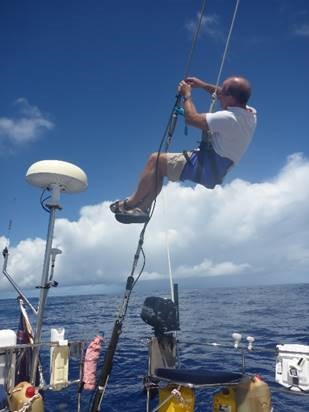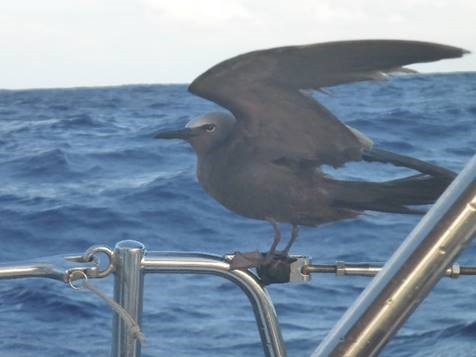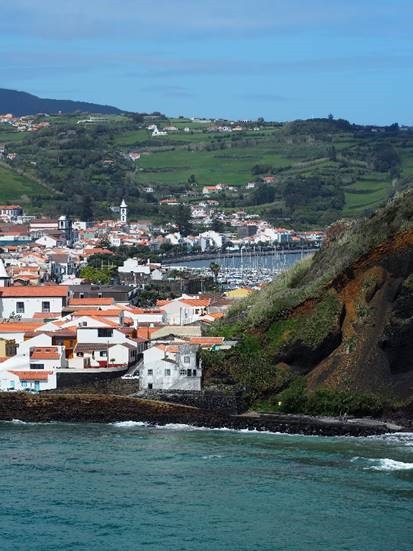6 May - Transatlantic Part 1 - and some Azorean delights

|
38:31.8N 028:37.6W
Faial at dawn We arrived in Horta, the main town on the island of Faial in the Azores, mid-morning on Thursday 2 May after 20 days at sea. The passage was slower than I would have liked and I would like to blame the weather: the uber-reliable ‘Azores High’ turned into an unusual ‘Azores Low’ which moved south west to find us and forced us to sail around it to avoid unpleasant headwinds. We had plenty of those too and for a couple of days were heavily reefed down, focused on nursing the boat through some quite nasty seas and gusty, unpredictable winds. On other days, we had flat calm seas and on balance, the wind was light – not the ideal for a heavy displacement ocean going yacht weighing in at around 25 tonnes.
Repairing the HF antenna mid-Atlantic Nonetheless, the boat performed superbly. So did my crew, Tom Reed and Ed Pearson. They are both very good racing sailors and highly professional Naval Officers, but neither had done such a long passage under sail before or been so far from land in a small boat. I really value the skillset that we all derive from our yacht racing backgrounds, but when you are a thousand miles from a safe haven, your thinking turns quite quickly to ‘I need to ensure nothing breaks’ when the weather turns nasty. They were particularly good at interpreting my direction on this and the result was that we arrived in one piece, pretty well rested and with no significant defects (apart from the blown spinnaker).
Tom and Ed Fuel management was critical in a 2500 mile passage: Escapade carries around 500 miles-worth of fuel and we needed to keep some in reserve in case the unthinkable happened: if the mast came down with 100 miles to go, we would look rather foolish without any diesel for the engine! The generator uses 2 litres and hour and ran for around 2.5 hours a day (unless the engine was running). The engine uses 5 litres an hour but gives a fairly reliable 7 knots of boat speed. Food was also something to watch. Food at sea is essential for morale and we left Jolly Harbour quite well stocked – though perhaps not as ‘pressed full’ as we should have been. Mid-Atlantic, I worried that we might be at sea for around 25 days, so started to hoard leftovers instead of letting Tom hoover the lot. Just incase the unthinkable happened… It didn’t and we arrived in Horta with one day of fresh meat and vegetables remaining (plus a freezer full of Tupperware ‘meals for one’…) Watchkeeping was straightforward. Tom and Ed worked a straight 1 in 2, four hours on, four hours off, throughout. I was available to assist with every sail change, run the HF weatherfax schedules and cook the meals. It meant that they were never shaken offwatch and I was always in tune with what was going on. On several mornings I would take over the watch at 0600 and go through until mid-morning, giving them both a bit of a ‘lie in’. It seemed to work. The weather disrupted our ‘Saturday Night at Sea’ and Easter Sunday Lunch’ events, so we rescheduled them for evenings during the week when the weather was more benign. The wildlife was interesting: we had a hitchhiker for 24 hours and would like to know what sort of bird appears in these photos. He was not the least bit afraid of us, but we don’t think he took any water or food off us either before he disappeared at dawn. We saw Storm Petrels and Shearwaters right across the ocean, huge numbers of Portuguese Man’o’War jellyfish in the second half of the crossing and plenty of dolphins in the last 1000 miles. No whales, though.
We decided to sail for Horta rather than Punta Delgada, our original destination, simply because it was 100 miles closer and we were keen to conserve fuel and not run out of wind.
A Portuguese Man’o’War under full sail! Horta has turned out to be a very good place. It’s a legendary refuelling stop for Transatlantic sailors and is well set up for us. The marina is first class and incredibly cheap after the Caribbean and North America. I challenge any American marina to provide an alongside berth on a properly built pontoon, with free water, electricity and wifi for $20 a night… Ashore, there are good restaurants, a decent supermarket, a good chandlery, friendly people and the unbeatable combination of a coffee and a Portuguese ‘Pastel Nata’ for €1.50. Peter’s Sports Bar is one of the most welcoming pubs I have been in in years. It’s a lovely, slightly sleepy Portuguese town, closely linked to the sea but with surprisingly little fishing today. The transiting yachtsmen provide most of the waterfront activity, so far as I could see.
Horta from the south – a Portuguese version of St Peter Port Tom and Ed managed to organise flight back to London on Friday. The local airline mucked them around as much as it could, first cancelling their lunchtime flights to Lisbon, then ringing them at 0840 on Friday morning instructing them to be at the airport by 0910. They got there (somehow); Ed got a seat but Tom didn’t… even though there were empty seats on the plane. He eventually got away after lunch and I’ve seen a phot of him at the rugby on FaceBook – so I guess it all worked out in the end! The weather has been a bit shabby since we got in, so rather than sail to Punta Delgada, I agreed with Peter Davies and Dave Godwin (my new crew) that they would join here in Horta. Dave was flying from the US, so had a particularly challenging time with delayed flights and a detour via Frankfurt, but they both appeared on Sunday morning as the sun came out! It's now Monday evening. The wind is howling and the rain is heavy, but it’s supposed to clear overnight and the forecast for the next few days is good. We’ve done some maintenance, fixed a couple of niggling defects, emptied the supermarket, filled the fuel and water tanks and are ready to go.
Superstitions run hard amongst sailors: you have to leave a record of your visit in Horta; this is my ‘quick and dirty’ effort in between rainshowers!
Others, with more time and more talent, have created a wonderful art gallery all around the harbour. Here are some of the several thousand paintings. So, for the next ten days or so, this blog will revert to ‘text only’ – a daily 1200Z update over the satellite. Next stop: Gosport!
|









